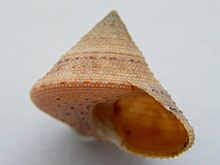NGC 2867
NGC 2867| 방출 성운 | |
|---|---|
| 행성상 성운 | |
 | |
| 관측 데이터: J2000 epoch | |
| 적경 | 09h 21m 25.38336s[1] |
| 적위 | - 58° 18° 40.6167°[1] |
| 거리 | 7,228 ly (2,228 pc)[2] ly |
| 겉보기 등급(V) | 9.7[3] |
| 외관 치수(V) | 12인치[4] 43.″3 × 35.″6[5] |
| 콘스텔레이션 | 카리나 |
| 지정 | ESO 126-8, PN G278.1-05.9,[6] Caldwell 90 |
NGC 2867(Caldwell 90)은 남쪽 용골자리에 있는 타원형[5] II[7] 행성상 성운으로 용골자리 NNW와 약 1도 이상 떨어져 있습니다.[8]이것은 1834년 4월 1일 존 허셜에 의해 발견되었다.허셜은 처음에 그가 새로운 행성을 발견했을지도 모른다고 생각했지만, 다음날 밤 다시 확인했고 그것이 움직이지 [3]않았다는 것을 발견했다.이 성운은 [2]태양으로부터 7,270광년 떨어진 곳에 위치해 있습니다.
이 성운의 중심별은 분광형[9] WC3으로, 이전에 주변 성운을 형성했던 대기를 벗어났던 백색왜성으로 진화하는 과정에 있습니다.현재는 크기가 0.3 미만인 비방사성 맥동을 겪고 있는 수소 결핍형 GW Vir 변광성이다.이 별의 온도는 165+18-20kK로
태양 반지름의 5%이며, 태양 [5]광도의 1,400배에 달하는 방사선을 방출하고 있다.
주변 성운은 매우 전형적이지만 탄소농축을 보여주고 있으며, 이는 원형별이 질량은 아니지만 세 번째 준설 과정을 거쳤음을 시사합니다.중심별의 범주는 [7]성운에서 매우 높은 수준의 이온화를 유발했습니다.성운의 모양은 다소 길어 보이는데, 이는 주변 성간 물질과의 상호작용을 나타낼 수 있습니다.성운 헤일로는 두 개의 할로(halo)가 합쳐진 것일 수 있으며, 이는 특이한 질량 손실 [10]역사를 나타낼 수 있습니다.
레퍼런스
- ^ a b VizieR에서 이 소스에 Brown, A. G. A.; et al. (Gaia collaboration) (August 2018). "Gaia Data Release 2: Summary of the contents and survey properties". Astronomy & Astrophysics. 616. A1. arXiv:1804.09365. Bibcode:2018A&A...616A...1G. doi:10.1051/0004-6361/201833051.대한 Gaia DR2 레코드.
- ^ a b Stanghellini, Letizia; et al. (December 10, 2008). "The Magellanic Cloud Calibration of the Galactic Planetary Nebula Distance Scale". The Astrophysical Journal. 689 (1): 194–202. arXiv:0807.1129. Bibcode:2008ApJ...689..194S. doi:10.1086/592395. S2CID 119257242.
- ^ a b O'Meara, Stephen James (2016). Deep-Sky Companions: The Caldwell Objects. Cambridge University Press. p. 415. ISBN 9781107083974.
- ^ "SEDS Online NGC Catalogue". Results for NGC 2867. Retrieved 2010-12-07.
- ^ a b c Keller, Graziela R.; et al. (August 2014). "UV spectral analysis of very hot H-deficient [WCE]-type central stars of planetary nebulae: NGC 2867, NGC 5189, NGC 6905, Pb 6 and Sand 3". Monthly Notices of the Royal Astronomical Society. 442 (2): 1379–1395. arXiv:1405.6763. Bibcode:2014MNRAS.442.1379K. doi:10.1093/mnras/stu878.
- ^ "NGC 2867". SIMBAD. Centre de données astronomiques de Strasbourg. Retrieved 2020-09-11.
- ^ a b Peña, M.; Stasińska, G. (July 2001). Aguilar, A.; Carramiñana, A. (eds.). Planetary Nebulae with [WR] nuclei. IX Latin American Regional IAU Meeting, "Focal Points in Latin American Astronomy", held in Tonantzintla, Mexico, Nov 9-13, 1998. Revista Mexicana de Astronomía y Astrofísica, Serie de Conferencias. p. 61. Bibcode:2001RMxAC..11...61P.
- ^ Sinnott, Roger W.; Perryman, Michael A. C. (1997). Millennium Star Atlas. Vol. 2. Sky Publishing Corporation and the European Space Agency. p. 994. ISBN 0-933346-83-2.
- ^ Werner, K.; et al. (June 1992). "A spectacular mass-loss event of the central star of Longmore 4". Astronomy and Astrophysics. 259: L69–L72. Bibcode:1992A&A...259L..69W.
- ^ Corradi, R. L. M. (2003). Kwok, Sun; Dopita, Michael; Sutherland, Ralph (eds.). Observations of Planetary Nebulae Haloes. Planetary Nebulae: Their Evolution and Role in the Universe, Proceedings of the 209th Symposium of the International Astronomical Union held at Canberra, Australia, 19-23 November, 2001. Astronomical Society of the Pacific. p. 447. Bibcode:2003IAUS..209..447C.


